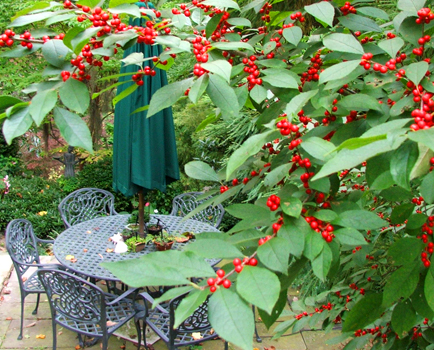|
|
|

The Winterberry Holly berries are ripe at Woodland Cottage.
- It’s a great time plant new plants and to transplant shrubs that might be in the wrong place. They will spend the winter rooting while the tops of the plants go dormant and they will be ready to grow in the spring. I always say that fall planting is the best-kept secret in the gardening world. There are exceptions: certain plants don’t establish themselves in the fall, for whatever strange reason; and things that are marginally hardy should not be planted in the fall because they might not have time to root well before the cold weather sets in. Being well-rooted gives them a better chance to survive the winter. I’m talking about things that are at their northern limit of hardiness where you live.
- I don’t like to fertilize in the fall because it promotes new growth in the warm days of early fall—only to be frozen off when the freezes come in. You want your plants to go naturally dormant so they can withstand winter, especially if it is severe.
- Lawns—An exception to the fertilizing rule is lawn fertilization on COOL SEASON grasses: fescues and bluegrasses. Fall is the big season to feed these grasses. Your local garden center can help you with fertilizer choices if you choose to feed your lawn. WARM SEASON grasses, like Zoysia, Bermuda, St. Augustine, etc. should NOT be fertilized until next spring—you want these grasses to go naturally dormant as it gets colder. Also, try to keep your lawn as free of leaves as possible as they fall.
- Continue watering, as needed, until you put the hoses away for the winter. Fall can be sunny with very low humidity, and very dry.
- No major pruning should occur now for the same reason you don’t want to fertilize: you don’t want to promote new growth. Minor trimming and shaping is fine; just no major pruning unless you absolutely have to do it.
- Get the weeds out now! They are all setting seeds and those seeds mean many more weeds next year! So save yourself some time in advance by weeding now when the weather is nicer than August!
- Seasonal color—pansies, mums, ornamental cabbage and kale—these and other seasonal plantings can go in as soon as the summer annuals lose their oomph. Pansies will make it until spring and should revive then; ornamental cabbage and kale usually get fried in the first bad freeze; and you decide on the mums—they are perennial so could possibly come back and bloom next year depending on the variety. Most people replant them every year, though.
- Bulbs—this is the time to plant. Daffodils, narcissus and most other bulbs can go in now until the ground freezes hard. Wait on tulips and hyacinths until at least November. The soil is too hot until then to plant these two. And remember to buy the best quality tulips and hyacinths you can afford…they decline after a few years in our hot summer soil. Think of tulips as a present to yourself and buy them fresh every year to get the best show. If you love tulips, it’s worth the money. And remember: deer love tulips, but won’t touch daffodils.
- Houseplants—it’s time to prepare to bring them in. Check for insects and spray accordingly if you believe in spraying. I usually start in early October and spray once a week for three weeks. Then I bring them in [usually] in late October just before the leaves start falling (earlier, of course, if there is a frost/freeze warning). Leaving them out as late as possible helps to knock them into dormancy which makes the transition to the indoors easier. Once inside, I give them as much light as possible and only water enough to keep them alive. I could care less if they grow over the winter…the only reason I have them inside is to decorate the rooms and stay alive until I can put them out again the following April. By then, they are beyond ready to go back outside.
I’ll have late winter clean-up and winterizing tips in the holiday newsletter around Thanksgiving.
Next story > Winter Garden Design
|



